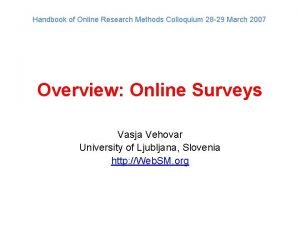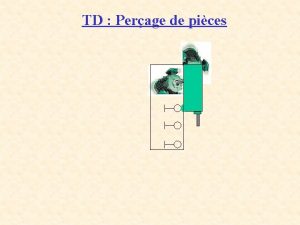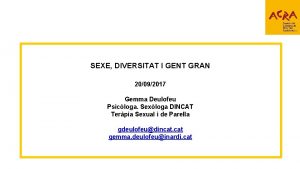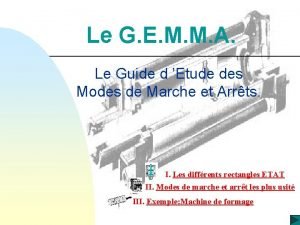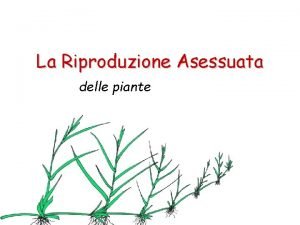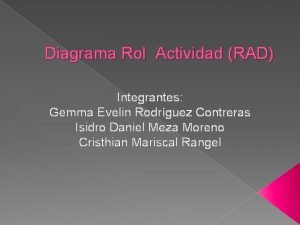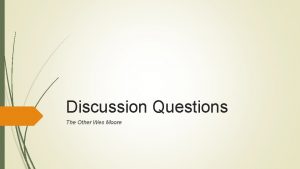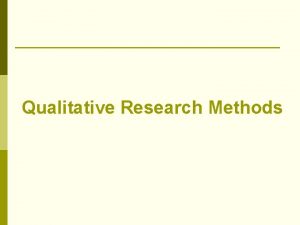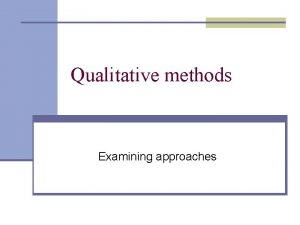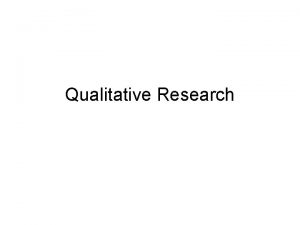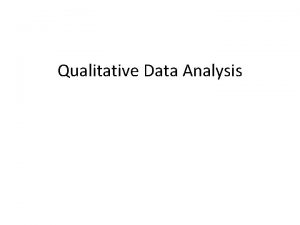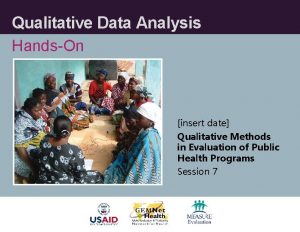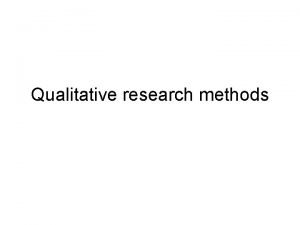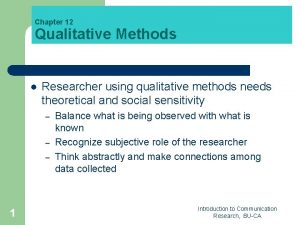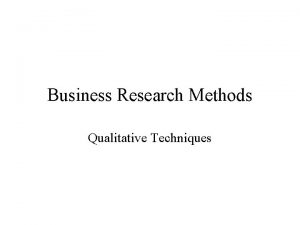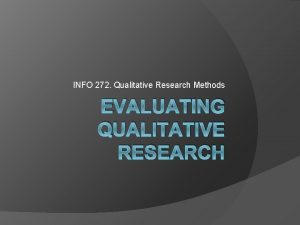Introduction to Qualitative Methods Dr Gemma Moore Ph



































- Slides: 35

Introduction to Qualitative Methods Dr. Gemma Moore Ph. D Qualitative Evaluation and Research Officer, Measurement for Improvement Team, Quality Improvement Division, HSE

Outline 1. What is Qualitative Research? 2. Designing Qualitative Projects 3. Qualitative Methods 4. Qualitative Data Analysis

1. What is Qualitative Research? Qualitative Research is ØA research strategy that emphasizes words rather than quantification in the collection and analysis of data Ø Explores peoples’ perspectives & experiences Ø Interprets and searches for meanings & implications in data ØPresents multiple and/or contrasting views and perspectives ØAcknowledges the impact of the researcher on the research process

Qualitative vs. Qualitative q Social research is divided into two paradigms:

Positivism: Quantitative Ø Approach taken from the natural sciences Ø Based on what can be recorded and observed Ø Usually tests a hypothesis which is generated from existing theory/knowledge Ø Views the researcher as independent and having no impact on data Ø Typically collects quantitative data uses large data sets and statistical analysis

Interpretivism: Qualitative Interpretivism Ø Critical of the scientific model being applies to social world Ø Understanding the world through the interpretation of that world by its participants Ø Uncovering subjective meanings Constructionism Ø Society is constructed through the creation of meanings, interactions and social structures which continually change Ø Emphasises the outcomes of interactions between people rather than phenomena that is ‘out there’

Quantitative Qualitative Positivism Interpretivism Deductive Inductive Objective Subjective Testable Hypothesis Exploratory Questions and Aims Design Fixed Fluid and Evolutionary Design Numerical Data in any form Repeatable Not Repeatable Generalisable Findings Not Generalisable Large Sample Small Sample Methods: Surveys, Questionnaires, Analysis of Existing Data Methods: Interviews, Focus Groups, Observation, Documentary. . .

Quality in Qualitative Research: Trustworthiness Source: http: //www. socialresearchmethods. net/kb/qualval. php

Criteria for Appraising Quality in Qualitative Research (Spencer et al. 2003) 1. How credible are findings? 2. Has knowledge/understandings been extended by the research? 3. How well does the evaluation address its original aims and purpose? 4. Scope for drawing wider inference – how well is this explained? 5. How clear is the basis of evaluative appraisal? 6. How defensible is the research design? 7. How well defended is the sample design/ target selection of cases/documents? 8. Sample composition/case inclusion – how well is the eventual coverage described? 9. How well was the data collection carried out? 10. How well has the approach to, and formulation of, the analysis been conveyed? 11. Contexts of data sources – how well are they retained and portrayed? 12. How well has diversity of perspective and content been explored? 13. How well has detail, depth and complexity (i. e. richness) of the data been conveyed? 14. How clear are the links between data, interpretation and conclusions – i. e. how well can the route to any conclusions be seen? 15. How clear and coherent is the reporting? 16. How clear are the assumptions/theoretical perspectives/values that have shaped the form and output of the evaluation? 17. What evidence is there of attention to ethical issues?

Bias in Qualitative Researcher Bias Confirmation bias, culture bias, sample bias, question-order bias, � leading questions and wording bias, the halo effect. Reflexivity � Ø Recognises researcher as part of the process

2. Designing Qualitative Research & Evaluations

Research Questions Research questions: Ø Should be the focus of your project and what you are seeking to find out Ø Should be relevant, feasible, answerable, concise & ethical Ø Can be exploratory, descriptive, explanatory or evaluative Ø May be more than one question and fall into a number of categories Ø Should determine the methodology, data collection methods and analysis Ø Can change or be refined as the research progresses

Research Design q The research question underpins the research design & implies what form the research project will take; Ø Background, literature review, methodological approach, sampling methods of data collection and data analysis q Descriptive Research designs are suitable for qualitative research Ø Longitudinal & case study research deigns suitable to qualitative methods Ø Experimental & cross-sectional more suitable to quantitative q Can employ different research strategies;

Sampling in Qualitative q The sample is determined by the research question, design and characteristics of the study sample q 3 main types of sampling: 1. Purposive Sampling Ø Sample chosen who fit criteria relevant to the research question 2. Quota Sampling Ø Takes into account percentage of sample population 3. Snowball or Chain-Referral Sampling Ø Participants refer on to their contacts q Sample size determined by purpose of the project, time, resources, sample accessibility or when data saturation is reached

Ethical Considerations Principles for Ethical Research (Belmont Report, 1979) 1. Respect for persons Ø 2. 3. Protect vulnerable particpants & maintain dignity Beneficence Ø Minimising the psychological and social risks Ø Maximising benefits to research participants Justice Ø Participants should share in the knowledge gained Does the project require ethical clearance and from which ethical committees?

Informed Consent Ø Ensure participants understand what it means to participate so they can then decide whether to participate Ø Information sheet should be provided that outlines: Ø The purpose of the research Ø What is expected of the research participant including time commitments Ø Expected risks and benefits to participants Ø The fact that participation is voluntary and consent can be withdrawn with no negative repercussions Ø How confidentiality will be protected Ø How data will be stored analysed and how the findings will be used Ø The contact details of the lead researchers for clarity on any questions Ø Verbal and written consent

3. Qualitative Methods Interviews Visual Methods Qualitative Methods Documentary Analysis Focus Groups Observation

Interview Types Face-to-Face, Telephone or Skype Ø 1. 2. 3. ideally tape record with participant’s permission and take notes Unstructured Ø Focus on a broad area for discussion Ø Participant talks about topic in their own way Semi-Structured Ø Common set of topics or questions for each interview Ø Questions vary depending on participant Ø Flexibility re order of questions Ø Follow up on topics that emerge Structured or Focused Interview Ø Identical set of questions for each interview Ø Questions asked in the same way, using the same words for each interview

Open Questions • • • • Can you tell me about. . . ? When did you notice. . . ? Why do you think that happened. . . ? What happened then. . . ? Do you think. . . ? How did you know. . . ? Did that affect. . ? How did you feel. . . ? What impact did that have on. . ? Who else was there, What did you see as the main. . . ? Where was that. . ? What did you think. . ?

Interview Skills Sensitivity to Interviewer/ee Interaction Establishing Rapport Listening Attentively without Passing Judgement Re-Focusing and Mainlining Control Use of Probes Learning the Language Non-Verbal Messages Encouraging Responses Non. Verbally Flexibility • Researching up, across or ‘down’? • Without affecting neutrality • Purpose of interview to hear participant’s perspective, experience and views • If going off topic given limited time • To illicit further information & get examples • Sensitive to cultural setting and discourse commonly used • Participant's body language if uncomfortable with a question • Expressions of understanding and interest, echoing their words, summarizing • To not interrupt - eye contact, head nodding, ‘um huh’ • To adapt to what emerges during the interview

Focus Groups q Focus Groups are an adaptation of interview technique - a group interview which is typically tape or video recorded with permission q Differs in that it seeks to generate discussion among the group with the help of the focus group facilitator q Usually 5 to 13 people who have something in common connected to the research topic (ideal = 6 -8) q Typically 1 -2 hours in length q Can include tasks for the group to complete eg. ranking/prioritising a list, buzz groups, etc. q Emphasis on interactions within the group, the content of the discussions and how the topics are discussed

Types of Focus Groups q Exploratory q Pre-pilot stage of forming a research topic q To discover what participants think is important about a topic q To assist the formation of interview questions or surveys q Observing and Recording q Emphasis on the way the group discusses a topic q Who leads, how language is used, how concepts are defined q Consultation and Evaluation q Participants asked to discuss a proposal q Participants asked to reflect on a project or event q Often includes a group task q Checking Back q To discuss emerging findings of interviews, surveys, focus groups etc with participants q Involving and Empowering Participants q Proving a sense of ownership in decision-making

Facilitating Focus Groups Managing the discussion Encourage members of the group interact Discussion stays focused on the topics Don’t lead or influence the discussion Aware of the group dynamics Time management Ensure all members participate Managing disagreements Facilitating tasks

Observation q Observation is the act of watching social phenomena in the real world and recording events as they happen Ø Takes place in the real world/ real situation Ø Can provide detailed rounded picture of phenomena or situation Ø Data recorded in situ Ø Rich data collected q Observation Types: Covert, Overt, Complete Observer or Complete Participant

Observation q Simple Observation Ø Researcher as objective outsider q Participant Observation Ø Researcher immersed in social situation Ø To achieve intimate knowledge of the setting or group Ø To understand people’s behaviours, cultural practices, power dynamics etc Ø To understand why specific practices occur , how they originate and change over time

Observation Considerations q Ethical Issues Ø Covert vs. Non- Convert Observation Ø Ethical Issues with covert? Ø Gaining informed consent from full group q Observer Effects (Hawthorne Effect) Ø Will people change their behaviour if they know they’re being observed? q Losing objectivity if immersed in a group – ‘Going native’ q Recording Data Ø Difficult to decide what to record q Time Consuming

Documentary Analysis Documents are often readily available potential sources of data Ø Contain large amounts of information Ø Static ‘snapshot’ of a particular time Ø Documents are socially constructed and can therefore tell us more than the information they contain Ø Useful when wanting to triangulate data

Documents Primary and Secondary Sources: Ø Written records Ø Policy and guidelines Ø Numerical data (census of population or surveys) Ø Qualitative data (report & findings of other research) Ø Mass media: newspaper, TV, documentaries, films Ø Personal documents (letters, diaries) Ø Historical documents Ø Visual or audio material

Other Methods Narratives Visual Methods Participant Diaries Participant Photos Secondary Data Poetry

4. Qualitative Data Analysis

Qualitative Data Analysis q The purpose of data analysis is to describe, discuss, evaluate and explain the content and characteristics of the data you have collected. q Data analysis should be: Systematic and Comprehensive 1. Ø All data should be treated in the same way Ø All data collected should be included in the analysis 2. Focused on Answering your Research Question/s 3. Grounded in Data 4. Dynamic and Flexible Ø To allow issues and themes to emerge during analysis

Types of Data Analysis Thematic Analysis • Explores the data for meaning • Looks for relationships between data • Explains the similarities, differences & relationships across the data • Uses indexing and coding to interpret the data • Identifies themes and develops categories Content Analysis • Focuses on words, latent meanings and relationships to each other • Word counting and frequency Narrative Analysis • Reads stories to gain understanding • Thematic analysis focusing on the way the narrative has been constructed Discourse Analysis • Analyzes the text for the type of language being used, the ideas that underlie the text and how the ideas are demonstrated through language • Examines how ideas are socially constructed; how ideas develop and change through time or in different settings Grounded Theory • Uses a clear, systematic techniques: Ø constant comparisons, coding, memos, identifying negative cases and data saturation

Coded Data

When is it Appropriate in QI projects? Ideally used at all stages of improvement interventions: q Conceptualisation: to inform the intervention objectives, identify issues, explore participant’s previous experiences and motivations, to pre-test the intervention. q Implementation: to establish the degree of compliance to the intervention plan, to capture issues and changes as they occur. q Evaluation: to establish the degree of implementation fidelity, assess whether the key components of the intervention were implemented and to what extent, to explore change issues, identify contextual issues, investigate the barriers and facilitators to the change intervention, sustainability of the intervention, and the lessons learnt.

Thank You! Email: gemma. moore 2@hse. ie
 Dr gemma moore
Dr gemma moore Dr gemma moore
Dr gemma moore Qualitative sampling methods
Qualitative sampling methods Qualitative research methods in political science
Qualitative research methods in political science Methodology errors
Methodology errors Characteristic of qualitative research
Characteristic of qualitative research Visual methods in qualitative research
Visual methods in qualitative research Qualitative research methods
Qualitative research methods Sampling methods in qualitative and quantitative research
Sampling methods in qualitative and quantitative research Qualitative research methods
Qualitative research methods Hermeneutic circle
Hermeneutic circle Integrating qualitative and quantitative methods
Integrating qualitative and quantitative methods Qualitative research methods
Qualitative research methods Qualitative forecasting methods
Qualitative forecasting methods Gemma procesarchitectuur
Gemma procesarchitectuur Gemma architectuur
Gemma architectuur Gemma augustea analyse
Gemma augustea analyse Gemma downey
Gemma downey Gemma del toro
Gemma del toro Le gemma
Le gemma Grafcet de conduite
Grafcet de conduite Gemma
Gemma Gemma donati dante
Gemma donati dante Gemma deulofeu
Gemma deulofeu Gemma costa
Gemma costa Paolo gemma
Paolo gemma Corpusculum lamellosum
Corpusculum lamellosum Gemma grafcet word
Gemma grafcet word Laura garriga
Laura garriga Spunta da una gemma
Spunta da una gemma Gemma bradshaw
Gemma bradshaw Tumbuhan yang termasuk tracheophyta
Tumbuhan yang termasuk tracheophyta Diagrama rad
Diagrama rad Gemma tetlow
Gemma tetlow Gemma laming
Gemma laming Discussion questions for the other wes moore
Discussion questions for the other wes moore












